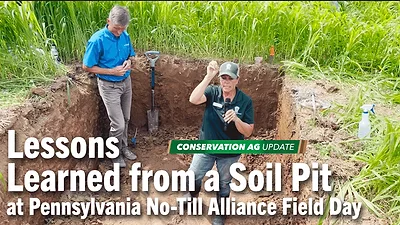After trying strip-till for the first time last spring on a small number of corn acres, Craig Mustard, his brother Chris and father Grant, plan to expand the practice on their farm in Canada, citing their early successes.

The family operates Musthaven Farms in Uxbridge, Ont., Canada, about an hour north of metropolitan Toronto.
The Mustards were the first farmers in their area to try strip-till. Several neighbors are interested in strip-till and one borrowed the Mustards’ strip-till rig to try it.
The Mustards bought the rig from Harco Ag Equipment in Harriston, Ont., a Blu-Jet dealer in the area that has been promoting strip-till, Craig says.
Mustard heard about strip-tilling in one of his agriculture classes at the University Guelph. The Ontario Ministry of Agriculture and Rural Affairs (OMAFRA) also has been promoting strip-till, as has a Blu-Jet dealer, Harco Ag Equipment.
“We grew well over 200 bushels of corn per acre with strip-till last year,” he says.
“The Blu-Jet system has 6 rows on 30-inch spacings. We put down no fertilizer. Then we came back and broadcast some granular urea with a spreader and worked it in with another pass of the strip-till rig.
“After that, we put on starter fertilizer with our six-row John Deere 7200 vacuum planter, which has 30-inch-row spacings,” he adds. “It also has Yetter trash whippers that we added.”
Saving Money
“We were really impressed with strip-till,” says Craig, whose family has dairy cows.
“Instead of having to use a 135-to-150 horsepower tractor for tillage, we pulled the strip-till rig with a 90-horsepower tractor. We used a lot less fuel and time to go across the field. We not only saved fuel, but also did more acres more quickly. With moldboard plowing, we can do a maximum of 30 to 40 acres a day. With strip-till, we can do at least twice that. That labor savings have been huge.”
Craig says they weren’t sold on going to no-till for their corn, but they wanted to reduce tillage. Strip-tilling delivers the benefits of deep tillage that moldboard plowing provided, without deep-tilling the whole field.
The Mustards did some trials last spring with strip-tilled corn, comparing it to moldboard plowing and other aggressive deep tillage.
“The weed control in the Roundup-Ready corn was good, even with the strip-till,” Mustard says
“We had a bit of a flush of weeds early in the growing season, in between the rows. We just went in and sprayed them, post-emergence, with Roundup. It looks like we need to get on the strip-tilled corn earlier to control weeds that moldboard plowing would bury.”
Managing Nutrients
Last fall, the Mustards strip-tilled some fields of continuous corn, as well as corn following alfalfa and winter wheat.
“The vast majority of our strip-tilled acres are corn-on-corn,” Mustard says.
“We grow about 200 acres of corn for grain and 40 to 45 acres for silage for our dairy. We just did the strips last fall. Because we have manure from dairy cows and heifers, some of our soils have a lot of phosphorus and potassium.
"As a result, we’re looking at putting phosphate and potash on with the corn planter because we don’t need high levels of fertilizer application.”For manure, the Mustards spread liquid dairy-cow and heifer manure before strip-tilling fields last fall and then worked it in. The soils they farm tend to be fairly light sandy-loam
“Water quality is a concern in the province,” Mustard says. “The government is especially interested in phosphorus in our area. We can access extra funding here because we’re in the Lake Simcoe watershed.”
The province provides financial incentives through its Environmental Farm Plan that farmers can apply for to use for strip-tilling. The Mustards have applied for EFP’s funding that they could use toward the costs of strip-tilling.
Lessons Learned
The Mustards learned several lessons from strip-tilling last year.
“One thing we found was that strip-tilling in the spring under good conditions only requires one pass instead of two even in untilled ground,” Craig says.
“We also found it was really easy to till too deep. We had to watch our depth control. We’re also trying to not cross fields with heavy loads to avoid leaving ruts and bumps in that won’t be erased by tillage.
“The soybeans will be a big experiment this coming year," he adds.
"We’re going to strip-till all of our soybeans in 30-inch rows this spring. With the price of soybean seed, we think we can save money vs. drilling them. We plan on putting down 100 to 150 pounds per acre of 6-24-24 for the soybeans.”





